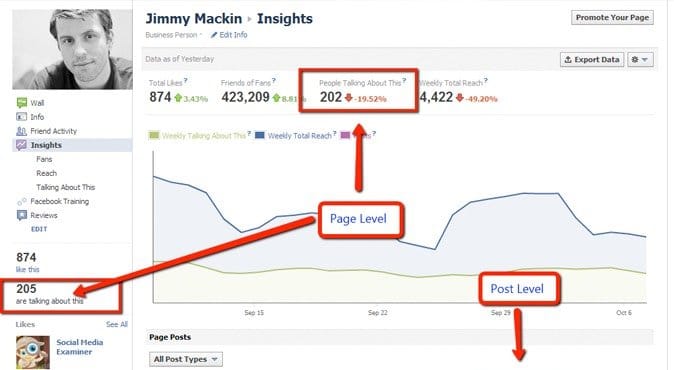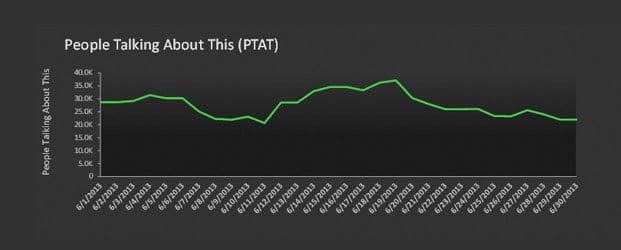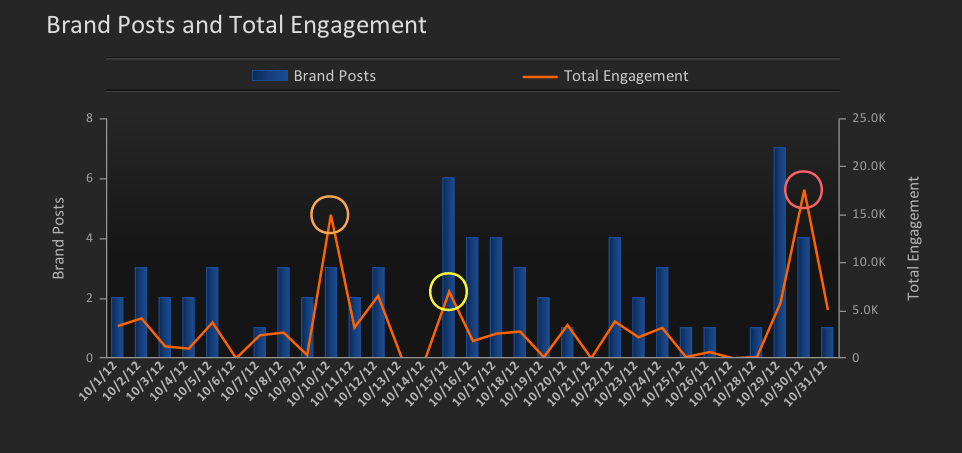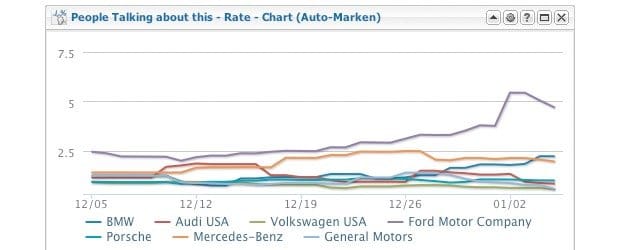 Written by ContentPowered.com
Written by ContentPowered.com
All the way back in March of 2014, Facebook declared that they would be removing the “People Talking About This” or PTAT metric from Insights.
Indeed, shortly after the announcements, that metric disappeared. They claimed they would be removing it from the API as well, but the fact is, it’s still visible. It’s just a little harder to get to than clicking into Insights.
How is People Talking About This Calculated?
The PTAT metric is a unique calculation, a sum total number, based on the last seven days. It totals up the number of actions that have created news feed stories about your brand. The actions that can generate such a story are:
- Liking a page, liking a post, or liking a check-in deal.
- Posting on the page’s wall, commenting on a post, or writing a recommendation.
- Sharing a post or a check-in deal.
- RSVPing to a page event.
- Answering a question or poll by the page.
- Mentioning the page (using the Facebook equivalent of @mention.)
- Tagging the page in a photo.
- Claiming an offer.
- Any likes, comments and shares of a post generated by one of the above actions.
Each of these actions results in a story being generated and posted to the person’s news feed, for their friends to see, based on their privacy settings.
This is, then, a sort of measurement of viral reach. If viral reach is the people who see a post based on an action one of your followers does after they see a post, then this is a sum total of all the potential vectors for viral reach in a given seven days.
This is a valuable metric to watch, though Facebook doesn’t want you watching it any more. They believed that it encouraged blind sharing and commenting without legitimate and valuable engagement. As true as this may be, this was also before they implemented several other changes, including the demotion of promotional and “share this for X” posts, which have begun to fall out of style.
Facebook also seems to believe that the actual reach measurements are a good alternative. I say that they’re two very different metrics, and that they’re both worth watching.
PTAT Vs Engagement
So what’s the difference between the People Talking About This metric and traditional post engagement? Well, in a sense, engagement and reach are more limited. Engagement measurement tends to only measure what’s on posts you make. If someone likes your page, and someone else comments on that story in that person’s news feed, that bit of engagement doesn’t count. With PTAT, it counts.
On the other hand, PTAT is hampered by the time limit. It’s strictly limited to the past seven days, meaning that if you have activity you would like to track earlier, you need to make note manually of the metric. When Facebook removed PTAT from Insights, so too did many analytics suites remove it from their features list. Even though it still exists, it’s harder to monitor.
Boosting PTAT
So what can you do to boost your People Talking About This, and is it beneficial? Well, obviously it’s going to be beneficial; any engagement, any sharing of your brand is good for you. If you’re familiar with lists of ways to increase your post engagement, this list will look similar.
- Post regularly throughout the week. Because PTAT is a measurement of seven days of activity, if you post in spurts, you won’t see a consistent number. Obviously, more people will be talking about you when you yourself are talking about you.
- Curate content, particularly content that you think has a good chance of drawing in a lot of interest from users. If you post something and users share it repeatedly, that’s going to earn you quite a bit of PTAT.
- Don’t forget some kind of social CTA in your messages. Ask people what they think, pose a question, run a poll, ask for shares; any social activity that generates a story is beneficial for both engagement and PTAT.
- Grow your audience. I know, easier said than done, but it’s really a good way to increase your PTAT. Because the metric is a raw number of people talking about you, it depends on volume. If you have a larger base audience, more people in sheer numbers will talk about your content, which boosts your PTAT numbers.
- Respond when a user posts a comment. Even if that response is a simple thanks, it grows confidence in your business. If you strike up a dialogue, those users will be growing your metrics every time they participate.
- Consider running events. An event with an RSVP system allows users to interact with your page in several ways. Each of those methods gives you a bump to your PTAT. Just make sure you’re not running an event when another means of promotion might be more beneficial.
- If you’re a local business, don’t forget the local metrics. Check-ins, Facebook’s Foursquare imitator, also help to increase your PTAT. The same is true when users leave you reviews or rate your business, because it counts as a post that mentions your business.
- Try to get other brands into a cross-promotion partnership. If another brand talks about you, it exposes you to their audience, which can be quite sizable while not overlapping with your own. This can dramatically increase your PTAT, though it’s most beneficial if it happens regularly.
- Maintain successful techniques. Again, because PTAT only shows seven days worth of data, it’s highly beneficial for you to do what you can to maintain your activity and your engagement. If you find something that works, keep it up.
While you’re watching your PTAT, by the way, you can also watch that of your competitors. It’s publicly visible information, it’s just not broken down in detail in your Insights like it used to be. Check out your competitors and see how they compare, in terms of audience size and PTAT. If they have a significantly higher PTAT with a similar audience, study their posts and figure out why.



